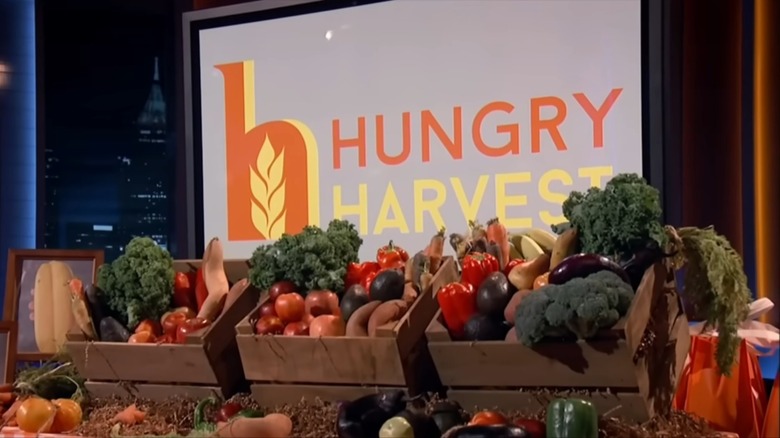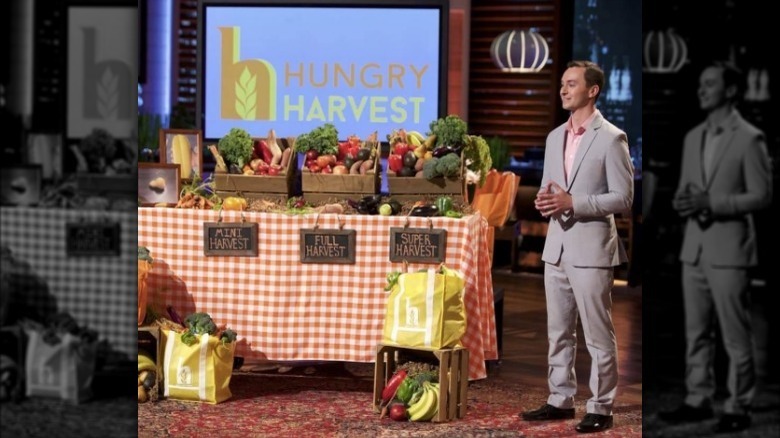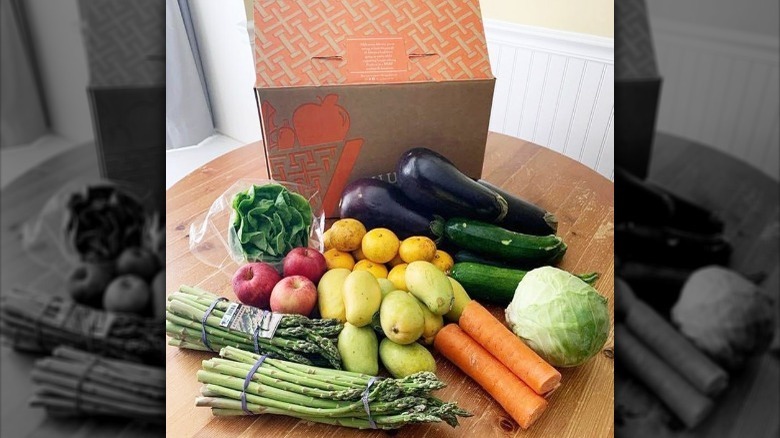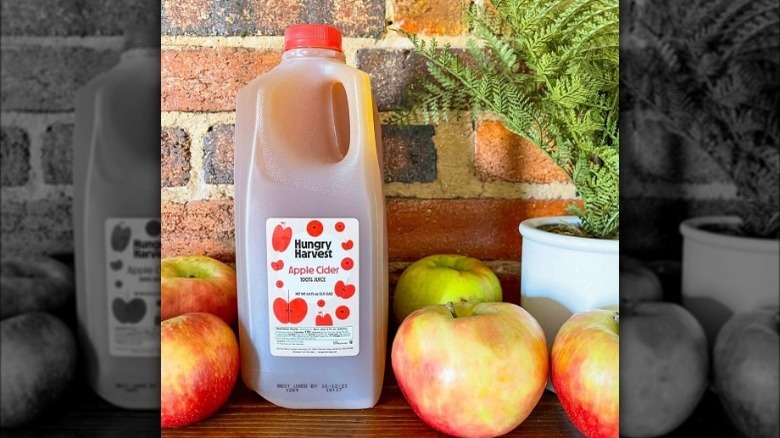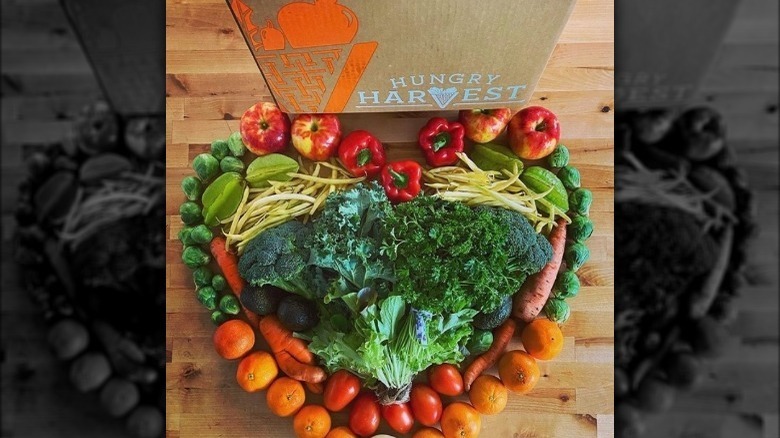Hungry Harvest: Here's What Happened After Shark Tank
"No elbows on the table" is one common saying many children hear at the dinner table. But, for Baltimore, Maryland native Evan Lutz, his family mealtime rule growing up had nothing to do with etiquette revolving around food, instead, it was vital that nothing goes to waste. Growing up, Lutz saw hunger firsthand throughout many of the city's most impoverished neighborhoods. Of course, food insecurity is prevalent around the world, but in the U.S., 12% of households face food insecurity (per FoodPrint). This is quite inconceivable, considering that more than 20 billion pounds of produce — much of which is still perfectly edible — goes to waste each year. So, Lutz decided to do something about it, founding the farm-to-doorstep produce delivery service Hungry Harvest in 2014.
The company's subscription service rescues fruits and vegetables that farmers and wholesalers are unable to sell — produce that would otherwise go to landfills — packages them up, and ships them out to customers. This provides an affordable and convenient way for them to save money and eat healthier all while giving back to their community.
Looking to grow his company at just 23 years of age, Lutz took the stage during Season 7, Episode 13 of "Shark Tank," which aired in January 2016. He handed out a bag of Hungry Harvest's rescued produce to each of the investors, Robert Herjavec, Lori Greiner, Kevin O'Leary, Barbara Corcoran, and Mark Cuban. But, would any of the Sharks be interested in taking a bite?
Hungry Harvest plants seeds on Shark Tank
After making only $37,000 in his first six months of business, and $104,000 in sales over the last six months prior to his pitch, Lutz was seeking $50,000 for a 5% stake in the company to help grow the food-justice startup.
The entrepreneur showcased three size options for his weekly subscription service, the Mini Harvest, Full Harvest, and Super Harvest, which ranged in price between $15 and $35 per week. He also explained more about the ethos behind the brand, noting that the company donates a healthy meal to someone in need for every bag of produce delivered.
Before taking a bite out of the brand, the Sharks had questions: Greiner wanted more information about its charitable component while O'Leary, who had previously invested in Plated, an ingredient-and-recipe meal kit service, was concerned about the logistics. Corcoran, on the other hand, just didn't think Lutz had the grit to build such a business, so she rejected the deal. Herjavec, however, was in, offering $100,000 for 10% equity. After briefly hesitating in the hopes that O'Leary would make an offer, Lutz accepted Herjavec's deal, later remarking that "dreams do come true."
Hungry Harvest sprouts after Shark Tank
Lutz made a splash in the "Tank" yet again, appearing on Season 12, Episode 7 of the show, which aired in December 2020. But this time, he wasn't seeking an investment deal. Instead, he gave a five-year update on Hungry Harvest — namely, that business was sprouting more than ever before. The founder revealed that the company had delivered more than two million boxes of fruits and vegetables to customers, keeping around 15 million pounds of produce from going to waste, which was a major increase from the 500 weekly customers the brand initially had six months after launching.
In total, Hungry Harvest had made $50 million in sales, which was certainly good news to Herjavec. "This is a great business: Not only does it help the community, it saves food waste, but it's making a profit," he said during the update. "It is great to do good, make money, and do more."
What's more, in September 2020, the brand revealed it had closed a Series A funding round, raking in a whopping $13.7 million from investment firm Creadev and other investors like Danone Manifesto Ventures, Quadia, and Maywic Select Investments.
Is Hungry Harvest still in business?
Fast forward to today, and business is still booming for Hungry Harvest. However, the company has undergone a few notable changes since its inception. For one, its deliveries are now sent in boxes in lieu of bags. In 2021, the brand updated its logo, noting on Instagram that its "new fresh look" gave it a "renewed sense of spirit to help create a better food system that nourishes every person." Organic produce is also available, and customers are now able to customize their choice of fruit, veggies, and herbs.
Moreover, it now offers grocery delivery options like beverages, dairy and egg products, pantry staples like rice and pasta, and even proteins, including plant-based meats and tofu. The brand even has its own line of products now, ranging from cold brews and dips to cheese and cookies. But, getting your hands on Hungry Harvest's goodies may be tricky. The company currently only delivers produce and groceries to Maryland, Washington D.C., northern Delaware, Virginia, the greater Philadelphia area, southern New Jersey, and Raleigh, North Carolina.
What's on the horizon for Hungry Harvest?
What's up next for Hungry Harvest remains to be seen, but one thing's for sure: The company is still committed to making a social impact by reducing food waste one box of produce at a time. And, to help fulfill its mission of getting produce to those in need, the brand continues to partner with mission-aligned schools and hunger-fighting organizations, such as the DC Food Project and the College Park Community Food Bank.
But, the company's good work doesn't stop there: Knowledgeable about the important link between nutrition and overall health — a connection that's been noted by the World Health Organization, among others — Hungry Harvest has also partnered with a number of hospitals and healthcare providers like Virginia Commonwealth University Health, Athena Health, and MedStar Health through HarvestRx. In an Instagram post, Lutz touched upon the importance of helping patients in need get access to nutritious, fresh produce, especially when it comes to "seeding healthier habits for positive, sustainable health outcomes for the future."

